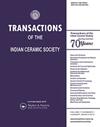形貌对二氧化钛-磁铁矿纳米颗粒净化废水光催化效率的影响
IF 1.5
4区 材料科学
Q3 MATERIALS SCIENCE, CERAMICS
引用次数: 0
摘要
在这项工作中,首次研究了磁铁矿形态对磁铁矿-二氧化钛纳米粒子(Fe3O4-TiO2 NPs)用于废水净化的磁性和光催化性能的影响。以七水硫酸亚铁和正钛酸四丁酯分别为磁铁矿和二氧化钛前驱体,采用水热法制备了磁铁矿和磁铁矿-二氧化钛纳米颗粒。x射线衍射和扫描电镜结果显示,成功合成了球形(Fe3O4S)、立方(Fe3O4C)和棒状(Fe3O4R)纳米粒子。Fe3O4C NPs的饱和磁性最高(66.36 emu.g−1),Fe3O4R的饱和磁性最低(35.11 emu.g−1)。通过在磁铁矿NPs上沉积二氧化钛,样品的饱和磁性大大降低。光催化亚甲基蓝(MB)脱色动力学符合一级模型。球形、立方和棒状磁铁矿对Fe3O4-TiO2 NPs的MB去除率分别大于90%、73%和64%,与同类产品相比有了较好的提高。有趣的是,与形貌相比,Fe3O4-TiO2 NPs的比表面积对光催化活性的影响更大。结果表明,Fe3O4C-TiO2 NPs具有最高的磁饱和度,而Fe3O4S-TiO2 NPs具有最高的光催化活性。结果表明,Fe3O4S-TiO2纳米粒子具有较好的磁性和光催化性能,有望用于废水净化。图形抽象本文章由计算机程序翻译,如有差异,请以英文原文为准。
The Effect of Morphology on the Photocatalytic Efficiency of Magnetite-Titania Nanoparticles for Wastewater Purification
In this work, for the first time, the effect of magnetite morphology on magnetic and photocatalytic properties of magnetite-titania nanoparticles (Fe3O4-TiO2 NPs) for waste-water purification was studied. Hydrothermal method was used to synthesize magnetite and magnetite-titania nanoparticles, using ferrosulfate heptahydrate and tetraubutyl orthotitanate as magnetite and titania precursors, respectively. X-ray diffractometry and scanning electron microscopy results revealed successful synthesis of spherical (Fe3O4S), cubic (Fe3O4C) and rod-like (Fe3O4R) NPs. Fe3O4C NPs had the highest (66.36 emu.g−1) and Fe3O4R had the lowest (35.11 emu.g−1) saturated magnetism. By depositing titania on the magnetite NPs, saturated magnetism was drastically reduced in the samples. The kinetics of photocatalytic methylene blue (MB) decoloration of the samples followed the first-order model. MB removal efficiency of Fe3O4-TiO2 NPs with spherical, cubic and rod-like magnetite was more than 90, 73 and 64%, respectively, after 120 min irradiation, which shows an excellent improvement compared to similar works. It was interesting that the specific surface area of Fe3O4-TiO2 NPs had a higher influence on photocatalytic activity compared to morphology. The results revealed that Fe3O4C-TiO2 NPs had the highest magnetic saturation, while Fe3O4S-TiO2 NPs had the highest photocatalytic activity. It was found that Fe3O4S-TiO2 NPs had the optimal magnetic and photocatalytic properties, and may potentially be used for wastewater purification. GRAPHICAL ABSTRACT
求助全文
通过发布文献求助,成功后即可免费获取论文全文。
去求助
来源期刊

Transactions of the Indian Ceramic Society
工程技术-材料科学:硅酸盐
CiteScore
2.40
自引率
8.30%
发文量
12
审稿时长
2.3 months
期刊介绍:
Transactions of the Indian Ceramic Society is a quarterly Journal devoted to current scientific research, technology and industry-related news on glass and ceramics. The Journal covers subjects such as the chemical, mechanical, optical, electronic and spectroscopic properties of glass and ceramics, and characterization of materials belonging to this family.
The Editor invites original research papers, topical reviews, opinions and achievements, as well as industry profiles for publication. The contributions should be accompanied by abstracts, keywords and other details, as outlined in the Instructions for Authors section. News, views and other comments on activities of specific industries and organizations, and also analyses of industrial scenarios are also welcome.
 求助内容:
求助内容: 应助结果提醒方式:
应助结果提醒方式:


